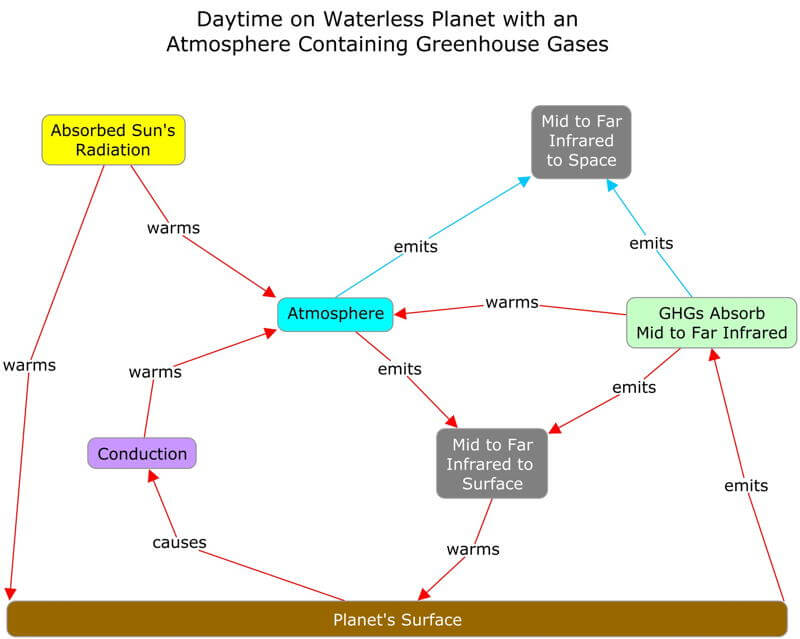Greenhouse Gases
What are GHGs?
Greenhouse gases (GHGs) absorb the mid to far-infrared emitted from the warmer Earth surface. Three key variables determine how much GHGs warm a planet:
-
- concentration in the atmosphere,
- how much energy do they absorb per molecule, and
- how long the molecule remains in the atmosphere (residence time).
How Do GHGs Warm a Planet?
Similar to a planet with an atmosphere without GHGs, these gases store heat through a variety of processes. But now, with GHGs, the atmosphere captures a portion of the thermal radiation emitted from the planet’s surface. Without GHGs, this radiation would have quickly left the planet, making the planet cooler. The atmosphere with GHGs is warmer, and part of the extra heat is transferred back to Earth’s surface, keeping it warmer. The bottom line, Earth’s atmosphere has been warm enough to allow water to remain in liquid form for much of its 4.5 billion years. And liquid water is critical for most types of life.
Earth without GHGs
Without GHGs in Earth’s atmosphere, the average global temperature would be 0ºF (-18ºC), so Earth’s water would freeze, and complex life would not exist. But can a planet have too much of a good thing? Take a look at Venus.

Concept map of the energy budget for a planet with an atmosphere with greenhouse gases but without water.
The Major Players
The two gases to the right are the critical GHGs, although the most focus is on carbon dioxide due to its long residence time and that humans are releasing large quantities for our energy and industrial needs. The gases below are also important, especially since humans have a role in releasing them into the atmosphere.
Water Vapor
This is the most potent GHG, and it usually is the highest GHG concentration, but it has a very short residence time – about 9 days! It condenses to form clouds (so no longer a gas) and forms precipitation which removes it from the atmosphere.
The effect of water on the Earth’s energy budget is complex. Evaporation, condensation, cloud reflectance, and precipitation all have large roles in warming and cooling the Earth’s surface and atmosphere.
Carbon Dioxide
Moderately absorbent to mid to far-infrared, carbon dioxide has a growing but minor concentration in the atmosphere. However, its residence time is on the order of a century, making it is a key GHG. In addition, methane, also a GHG, oxidizes to carbon dioxide in about a decade in the atmosphere.
Methane
Both given off by natural and human sources, methane is roughly two orders of magnitude more potent than carbon dioxide as a GHG, but it chemically alters to carbon dioxide in about a decade. So ultimately it is a source of long-term atmospheric warming but in the form of carbon dioxide.
Nitrous Oxide
This is a potent natural and human-generated GHG that has a residence time of roughly a century but fortunately has a low concentration in the atmosphere.
Chlorofluorocarbon (CFCs)
This is a potent human-generated GHG that has a residence time of roughly a millennium but fortunately has a very low concentration in the atmosphere.

0 Comments